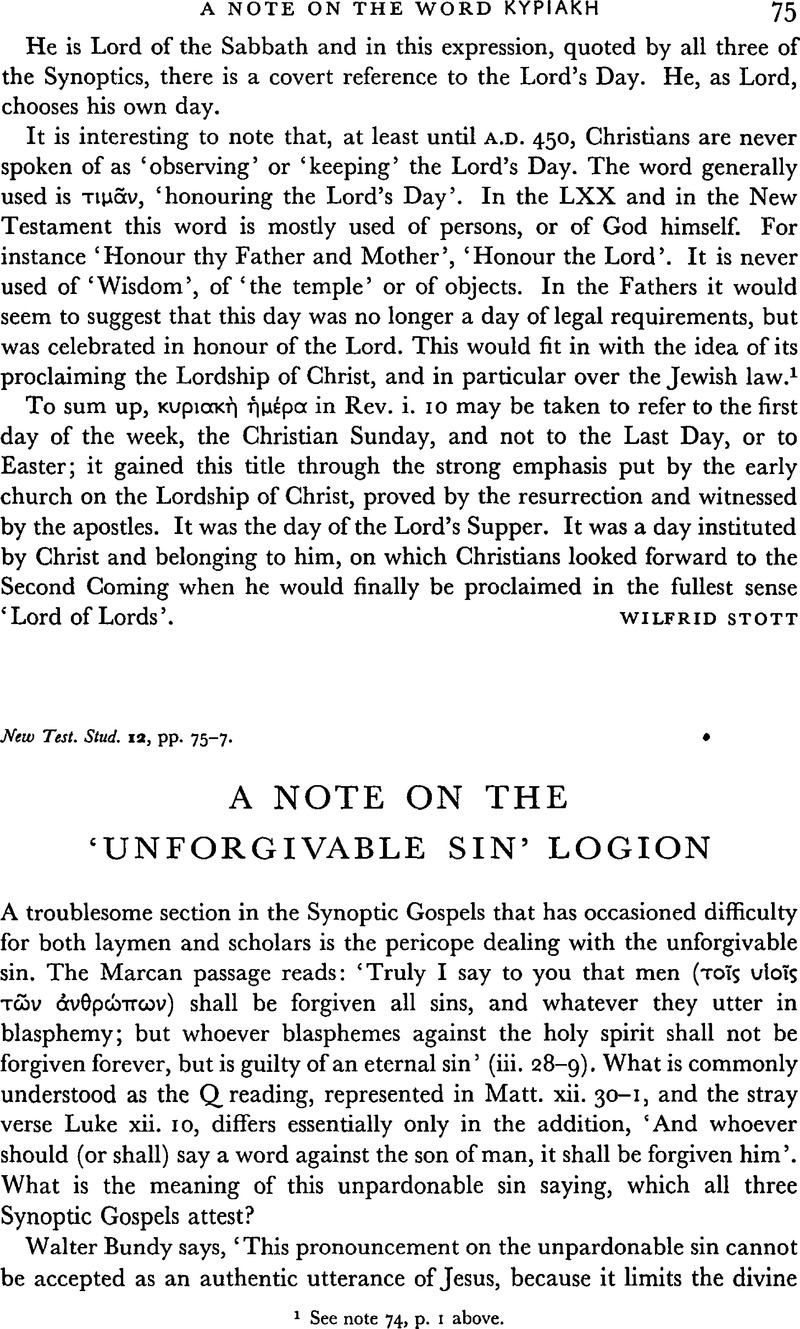Article contents
A note on the ‘Unforgivable Sin’ Logion
Published online by Cambridge University Press: 05 February 2009
Abstract

- Type
- Short Studies
- Information
- Copyright
- Copyright © Cambridge University Press 1965
References
page 75 note 1 See note 74, p. 1 above.
page 76 note 1 Jesus and the First Three Gospels (Cambridge, Mass.: Harvard U.P. 1955), p. 212.Google Scholar
page 76 note 2 Ibid.
page 76 note 3 Die Geschichte der synoptischen Tradition, 3. Auflage (Göttingen: Vandenhoeck and Ruprecht, 1957), pp. 138f.Google Scholar
page 76 note 4 , Bornkamm, Barth, Gerhard, Held, Heinz Joachim, überlieferung and Auslegung im Matthäus Evangelium (Netherlands: Neukirchener Verlag, 1960), pp. 31 f.Google Scholar
page 76 note 5 The Gospel According to Luke (London: Macmillan and Co. Ltd, 1953), p. 172.Google Scholar
page 76 note 6 Op. cit.
page 76 note 7 Moore, George F., Judaism, 1 (Cambridge, Mass.: Harvard U.P. 1962), p. 237Google Scholar; see also p. 421.
page 76 note 8 Ibid. I, 437; 111, 134, note 167.
page 76 note 9 ‘Op. cit. p. 31.Google Scholar
page 74 note 1 On Jesus’ eschatological preaching, cf. Bultmann, , Jesus and the Word, trans. Louise Pettibone Smith and Erminie Huntress Lantero (New York: Scribner’s Sons, 1958), pp. 27 ff.Google Scholar, and ‘Jesus and Paul’, Existence and Faith, trans. Ogden, Schubert (New York: Meridian Books, 1960), pp. 186ff.Google Scholar; concerning both his preaching and other characteristics of his ministry, cf. Bultmann, , Dos Verhdltnis der urchristlkhen Christusbotschaft zum historischen Jesu (Heidelberg: Carl Winter, Universitatsverlag, 1962), pp 11, 15ff.Google Scholar
page 74 note 2 Cf. Bultmann, , ‘Jesus and Paul’, op. cit. pp. 194.ff.Google Scholar
page 74 note 3 Although I would admit with Bultmann that Mark, ii. 5b–10Google Scholar is an insertion out of a wonder-tale background (cf. Geschichte, , pp. 12f.Google Scholar and New Testament Theology, I, trans. Grobel, Kendrick [New York: Scribner's Sons, 1951], p. 61Google Scholar), I would not contend that along with exorcism, which B. admits as a characteristic of Jesus’ ministry, the forgiveness of sins would have been associated with his ministry. Sickness, possession by demons and sin and guilt were too closely connected in the world view of Jesus’ era for it to have been otherwise. On the connexion between pneumatic gifts and healing, exorcism and forgiveness of sins, see Volz, Paul, Der Geist Gottes (Tübingen: J. C. B. Mohr, 1910), especially pp. 125ff., 135.Google Scholar
page 74 note 4 ‘Jesus and Paul’, op. Cit. p. 195.Google Scholar
- 1
- Cited by


